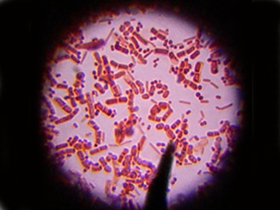When we look at the pre-cellular stages of life, we see evolution here, too. The first, most primitive forms of biological organisms are not cells, but viruses.146
 A virus lives as a parasite in the cells of a foreign organism. Viruses have no metabolisms of their own outside the host cell. The diagram above shows how a virus takes over a cell. It first attaches itself to the cell, then injects it with its own DNA. The cell is thus forced into copying the virus. Eventually, the cell explodes and the new virus particles are released. |
On the one hand, while evolutionists seek to account for the origin of life in terms of viruses, they also say that viruses cannot represent the foundation of life. This impossibility is mentioned in a number of evolutionist sources:
Viruses were initially regarded as very small organisms. It was later established in detailed studies conducted under the electron microscope that these were structurally very different and that they lived solely as parasites in the cell.
No matter how many virions one or a few enzymes contain, this enzyme series is still insufficient for establishing a virion. (virion, the state in which viruses have the capacity to cause infection). 147
 Viruses are not the origin of life. |
Viruses multiply as parasites in the cells of a foreign organism. They have no metabolisms beyond those of the host cells. Since viruses have no metabolisms and ability to be stimulated they do not possess the features of independence unique to life, and are therefore not truly alive, in the usual sense.
Viruses are known as virions when they are still outside the cell. Virions are not alive. Only two of the key processes in living things are found in viruses: replication and mutation. Viruses cannot perform these functions independently outside the cell, in their form as virions. They need complete organisms in order to "come to life.".148
As you can see, viruses cannot be regarded as a pre-life stage, because they can perform such key stages as replication and mutation only in the cells of the organisms they inhabit. Viruses are unable to survive in the absence of a complete organism. For that reason, there can be no question of their constituting a preliminary stage for bacteria, for example.
Professor Ali Demirsoy, a Turkish expert on evolution, refers to the invalidity of the claims regarding the origins of viruses:
Our accumulated knowledge is far from telling us about the origin of viruses and their development to date. At the same time, the existence of three very different physical stages, and the inability of any one of these to provide a fully satisfactory account regarding viruses, makes any comment even more difficult. The comments summarized below are based more on fiction than on scientific foundations.
Once upon a time, the origins of viruses were cellular organisms. These vital cells entered other cells as parasites and gradually lost all their organelles.
The origins of viruses were a free-living pre-cell. Later, with the emergence of cellular organisms, these primitive forms began living inside them as parasites.
Viruses are descended neither from pre-cells nor form cellular organisms. They emerged from fragments released from the genetic material of other organisms.
Although the first concept was for long favored by microbiologists, it is now regarded as the least likely. Because there are such profound differences between the two groups that one cannot be hypothesized as the origin of the other. Although the second possibility appears rather more attractive, it also appears impossible for the reasons cited above. No intermediate form between organisms and viruses has ever been found. The last possibility appears more reasonable.149
As you can see from these comments, viruses do not represent the beginning of life. Even evolutionist biologists point the living organisms as the origin of viruses.
146. Prof. Dr. Muammer Bilge, Hücre Bilimi, p. 59.
147. Prof. Dr. Ali Demirsoy, Kalıtım ve Evrim, pp.65, 72.
148. M. Yılmaz Öner, Canlıların Diyalektiği ve Yeni Evrim Teorisi, pp. 84-89.
149. Prof. Dr. Ali Demirsoy, Kalıtım ve Evrim, p. 73.


